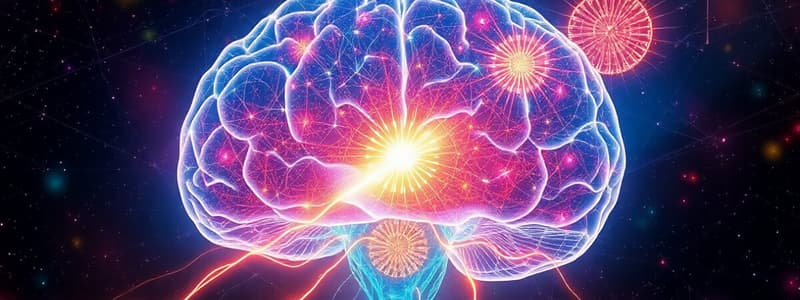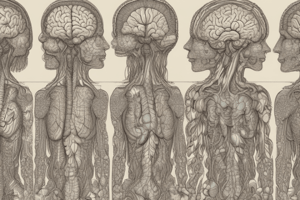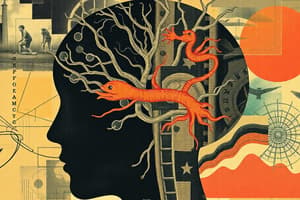Podcast
Questions and Answers
Why are chimpanzees considered a useful 'stand-in' for the common ancestor of humans and chimpanzees?
Why are chimpanzees considered a useful 'stand-in' for the common ancestor of humans and chimpanzees?
- Chimpanzees have shorter evolutionary history compared to humans.
- Chimpanzees display characteristics more similar to those of the proposed common ancestor than modern humans do. (correct)
- Chimpanzees are more intelligent than modern humans.
- Chimpanzees have larger brains relative to their body size compared to humans.
What is the primary principle used to reconstruct the evolution of the human brain and behavior?
What is the primary principle used to reconstruct the evolution of the human brain and behavior?
- Comparing modern human behavior to current animal behavior.
- Studying the development of the brain in individual humans.
- Using the principle of common ancestry to trace evolutionary events. (correct)
- Analyzing the genetic mutations that occurred in early humans.
Which of the following is the MOST accurate description of a 'nerve net'?
Which of the following is the MOST accurate description of a 'nerve net'?
- A system of neurons organized with bilateral symmetry and segmentation.
- A diffuse network of neurons that receive sensory information and connect directly to neurons that move muscles. (correct)
- A centralized cluster of neurons found in invertebrates.
- A complex structure composed of a brain and spinal cord.
What does the term 'encephalization' refer to in the context of nervous system evolution?
What does the term 'encephalization' refer to in the context of nervous system evolution?
Which of the following best describes the significance of the notochord in chordates?
Which of the following best describes the significance of the notochord in chordates?
What is the MOST accurate definition of 'taxonomy'?
What is the MOST accurate definition of 'taxonomy'?
How does the folding of the brain in large-brained mammals contribute to their cognitive abilities?
How does the folding of the brain in large-brained mammals contribute to their cognitive abilities?
Which of the following is NOT a basic structural pattern common to all chordates nervous systems?
Which of the following is NOT a basic structural pattern common to all chordates nervous systems?
Which sequence accurately represents the evolutionary steps in the development of a nervous system, from earliest to latest?
Which sequence accurately represents the evolutionary steps in the development of a nervous system, from earliest to latest?
In a cladogram, what do the branch points (nodes) represent?
In a cladogram, what do the branch points (nodes) represent?
Approximately how long ago did animals evolve the first brain cells?
Approximately how long ago did animals evolve the first brain cells?
How is the distance between branch points interpreted in a cladogram?
How is the distance between branch points interpreted in a cladogram?
What is the significance of bilateral symmetry in the evolution of nervous systems?
What is the significance of bilateral symmetry in the evolution of nervous systems?
What is the primary difference between a common ancestor and a typical relative, as illustrated by the Joan Campbell example?
What is the primary difference between a common ancestor and a typical relative, as illustrated by the Joan Campbell example?
Which key evolutionary development led to the forms of movement (behavior) that distinguish members of the animal kingdom?
Which key evolutionary development led to the forms of movement (behavior) that distinguish members of the animal kingdom?
What characteristic is shared by the human spinal cord and earthworms, in terms of nervous system organization?
What characteristic is shared by the human spinal cord and earthworms, in terms of nervous system organization?
Why is understanding common ancestry important in the study of nervous system development across species?
Why is understanding common ancestry important in the study of nervous system development across species?
Which of the following best describes the relationship between brain size and behavior in chordates?
Which of the following best describes the relationship between brain size and behavior in chordates?
What distinguishes chordates from other animal phyla in terms of nervous system structure?
What distinguishes chordates from other animal phyla in terms of nervous system structure?
According to the information provided, which of the following statements is TRUE regarding the necessity of a nervous system for life?
According to the information provided, which of the following statements is TRUE regarding the necessity of a nervous system for life?
Which of the following is implied by the statement that the human PNS is reminiscent of the nerve net observed in phylogenetically simpler animals?
Which of the following is implied by the statement that the human PNS is reminiscent of the nerve net observed in phylogenetically simpler animals?
The evolution of a spinal cord represents a significant advancement over which structure?
The evolution of a spinal cord represents a significant advancement over which structure?
How do cladograms aid in understanding the evolution of animal species?
How do cladograms aid in understanding the evolution of animal species?
In what way does segmentation contribute to the complexity of the nervous system?
In what way does segmentation contribute to the complexity of the nervous system?
Which of the following groups of animals exhibits the greatest degree of cephalization?
Which of the following groups of animals exhibits the greatest degree of cephalization?
What does the evolution of muscles and nervous systems together suggest about early animal development?
What does the evolution of muscles and nervous systems together suggest about early animal development?
In the context of evolution, what makes ganglia 'resemble primitive brains'?
In the context of evolution, what makes ganglia 'resemble primitive brains'?
The presence of bilateral symmetry in an animal's nervous system correlates with which of the following?
The presence of bilateral symmetry in an animal's nervous system correlates with which of the following?
Neurons and muscles likely have their origins in:
Neurons and muscles likely have their origins in:
What is the name of the chart that is used to display the hypothetical phylogenetic relationships among animal species?
What is the name of the chart that is used to display the hypothetical phylogenetic relationships among animal species?
In evolutionary terms, how recent was the appearance of large, complex brains?
In evolutionary terms, how recent was the appearance of large, complex brains?
Which of the following best describes the function of a nerve net?
Which of the following best describes the function of a nerve net?
What distinguishes humans among all chordates in terms of brain size?
What distinguishes humans among all chordates in terms of brain size?
Which of the following can be inferred from the increasing brain size and folding in primates?
Which of the following can be inferred from the increasing brain size and folding in primates?
The structure of the human spinal cord resembles:
The structure of the human spinal cord resembles:
Within the taxonomic hierarchy, what level of classification is broader than 'class' but more specific than 'kingdom'?
Within the taxonomic hierarchy, what level of classification is broader than 'class' but more specific than 'kingdom'?
Flashcards
Common ancestor
Common ancestor
Forebear from which two or more lineages arise.
Taxonomy
Taxonomy
Branch of biology naming/classifying species by grouping organisms based on shared characteristics and relationships.
Taxonomic hierarchy
Taxonomic hierarchy
Kingdom, phylum, class, order, family, genus, and species.
Phylogeny
Phylogeny
Signup and view all the flashcards
Cladogram
Cladogram
Signup and view all the flashcards
Nerve net
Nerve net
Signup and view all the flashcards
Bilateral symmetry
Bilateral symmetry
Signup and view all the flashcards
Segmentation
Segmentation
Signup and view all the flashcards
Ganglia
Ganglia
Signup and view all the flashcards
Encephalization
Encephalization
Signup and view all the flashcards
Spinal cord
Spinal cord
Signup and view all the flashcards
Chordates
Chordates
Signup and view all the flashcards
Brain
Brain
Signup and view all the flashcards
Study Notes
Evolution of Brains and Behavior
- The study of nervous system development across species can be aided by understanding common ancestry
- Reconstruction of human brain evolution can be achieved by:
- Study of animals that first developed a nervous system and muscles
- Observing how the nervous system grew in complexity as the brain evolved to mediate behavior
- Examining how the human brain attained its current complexity
- Common ancestry uses a forebear from which two or more lineages or family groups arise
- Humans and other apes share common ancestors
- Chimpanzees are more similar to a proposed common ancestor of humans and chimps than modern humans
Origin of Brain Cells and Brain
- Earth formed 4.5 billion years ago, and the first life-forms arose about a billion years later
- Animals evolved the first brain cells roughly 700 million years ago
- Evolution of the first brain occurred around 250 million years ago
- A humanlike brain emerged approximately 6 million years ago
- The modern human brain has only been around for the past 200,000 years
- Large, complex brains appeared very recently when considering evolutionary timescales
The Basics: Classification of Life
- Taxonomy names and classifies species by grouping organisms according to shared characteristics and relationships
- Broadest classification unit: kingdom
- Subordinate groups: phylum, class, order, family, genus, and species
- Humans are in the animal kingdom, chordate phylum, mammalian class, the primate order, the great ape family, the genus Homo, and the species sapiens
- Homo sapiens sapiens means "wise, wise human"
- Cladograms illustrate the evolutionary sequence connecting all living organisms
- Animalia is the most recently evolved kingdom containing species with muscles and nervous systems
- Muscles and nervous systems evolved together to facilitate movement (behavior)
Evolution of Nervous Systems in Animals
- A nervous system is not essential for life, with most organisms doing without one for their existence
- In animals with a nervous system, it evolved through these steps:
- development of neurons and muscles
- formation of a nerve net
- bilateral symmetry
- segmentation
- ganglia
- spinal cord
- brain
Process of Nervous System Evolution
- Brain cells and muscles evolved together, facilitating movement in animals
- Neurons and muscles originated in single-cell animals that developed various ways of moving
- A nerve net is a simple nervous system found in older phyla, like jellyfish and sea anemones
- Nerve nets have no brain or spinal cord structure; they consist of neurons receiving sensory information and connecting to muscles
- The human PNS is reminiscent of the nerve net seen in simpler animals
- Bilateral symmetry is an organization exhibited in more complex animals (such as flatworms)
- The nervous system on one side of the animal mirrors the other
- The human nervous system is bilaterally symmetrical
- Segmentation: the body consists of a series of similar muscular segments
- The human spinal cord and brain display segmentation
- Ganglia: clusters of neurons found in more recently evolved invertebrate phyla
- Ganglia resemble primitive brains and work as command centers
- Encephalization is a characteristic that some phyla possess
- Insects have ganglia that are large enough to be called a brain
- Spinal cord: a single nervous system pathway connecting the brain with sensory receptors and muscles in chordates
- Chordates are named for the notochord, a flexible rod along the back
- In humans, the notochord only exists in the embryo, later encased in bony vertebrae
- Brain: a true brain is displayed in the chordate phylum, which includes amphibians, reptiles, birds, and mammals, which are class members
- Chordates display the greatest degree of encephalization
Chordate Brains
- Humans have the largest brain relative to body size among chordates
- Brains of chordate species are built to a common plan, but display specializations related to behavior
- A cladogram depicts the hypothetical phylogenetic relationships between animal species in a branching diagram
- Branch points (nodes) in a cladogram represent common ancestors
- Chordate cladograms depict seven of the nine classes to which the roughly 38,500 extant chordate species belong
- Variation exists amongst nervous systems of chordates, but there is a common structural pattern
- All chordates display bilateral symmetry, segmentation, and a spinal cord and brain encased in cartilage or bone
- Brain size increase in chordates is related to forms of locomotion
- Chordates have a brainstem, but birds and mammals have a large forebrain and cerebellum
- Large-brained mammals have extensively folded brain structures, increasing surface area within a small skull
- Increased size and folding are seen in primates, enhancing complex movements, manipulation, learning, and social behavior
Studying That Suits You
Use AI to generate personalized quizzes and flashcards to suit your learning preferences.




